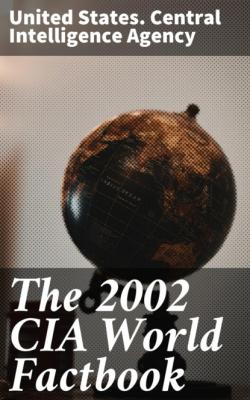ТОП просматриваемых книг сайта:
The 2002 CIA World Factbook. United States. Central Intelligence Agency
Читать онлайн.Название The 2002 CIA World Factbook
Год выпуска 0
isbn 4064066092382
Автор произведения United States. Central Intelligence Agency
Жанр Социология
Издательство Bookwire
Administrative divisions: 12 municipalities (manatiq, singular - mintaqah); Al Hadd, Al Manamah, Al Mintaqah al Gharbiyah, Al Mintaqah al Wusta, Al Mintaqah ash Shamaliyah, Al Muharraq, Ar Rifa' wa al Mintaqah al Janubiyah, Jidd Hafs, Madinat Hamad, Madinat 'Isa, Juzur Hawar, Sitrah note: all municipalities administered from Manama
Independence: 15 August 1971 (from UK)
National holiday: National Day, 16 December (1971); note - 15 August 1971 is the date of independence from the UK, 16 December 1971 is the date of independence from British protection
Constitution: adopted late December 2000; Bahrani voters approved on 13-14 February 2001 a referendum on legislative changes (revised constitution calls for a partially elected legislature, a constitutional monarchy, and an independent judiciary)
Legal system: based on Islamic law and English common law
Suffrage: none
Executive branch: chief of state: King HAMAD bin Isa Al Khalifa (since 6 March 1999); Heir Apparent Crown Prince SALMAN bin Hamad (son of the monarch, born 21 October 1969) head of government: Prime Minister KHALIFA bin Salman Al Khalifa (since NA 1971) cabinet: Cabinet appointed by the monarch elections: none; the monarchy is hereditary; prime minister appointed by the monarch
Legislative branch: unicameral National Assembly was dissolved 26 August 1975 and legislative powers were assumed by the Cabinet; appointed Advisory Council established 16 December 1992; the National Action Charter created a bicameral legislature on 23 December 2000; approved by referendum of 14 February 2001
Judicial branch: High Civil Appeals Court
Political parties and leaders: political parties prohibited but politically oriented nongovernment organizations are allowed
Political pressure groups and leaders: Shi'a activists fomented unrest sporadically in 1994-97, demanding the return of an elected National Assembly and an end to unemployment; several small, clandestine leftist and Islamic fundamentalist groups are active
International organization participation: ABEDA, AFESD, AL, AMF, CCC,
ESCWA, FAO, G-77, GCC, IBRD, ICAO, ICC, ICRM, IDB, IFC, IFRCS, IHO,
ILO, IMF, IMO, Interpol, IOC, ISO (correspondent), ITU, NAM, OAPEC, OIC,
OPCW, UN, UNCTAD, UNESCO, UNIDO, UPU, WFTU, WHO, WIPO, WMO, WToO, WTrO
Diplomatic representation in the US: chief of mission: Ambassador
Khalifa bin Ali bin Rashid AL KHALIFA chancery: 3502 International Drive
NW, Washington, DC 20008 FAX: [1] (202) 362-2192 consulate(s) general:
New York telephone: [1] (202) 342-0741
Diplomatic representation from the US: chief of mission: Ambassador
Ronald E. NEUMANN embassy: Building #979, Road 3119 (next to Al-Ahli
Sports Club), Block 321, Zinj District, Manama mailing address: American
Embassy Manama, PSC 451, FPO AE 09834-5100;
American Embassy, Box 26431, Manama telephone:
Flag description: red with a white serrated band (eight white points)
on the hoist side
Economy Bahrain
Economy - overview: In Bahrain, petroleum production and refining account for about 60% of export receipts, 60% of government revenues, and 30% of GDP. With its highly developed communication and transport facilities, Bahrain is home to numerous multinational firms with business in the Gulf. Bahrain is dependent on Saudi Arabia for oil revenue granted as aid. A large share of exports consists of petroleum products made from refining imported crude. Construction proceeds on several major industrial projects. Unemployment, especially among the young, and the depletion of oil and underground water resources are major long-term economic problems.
GDP: purchasing power parity - $8.4 billion (2001 est.)
GDP - real growth rate: 4% (2001 est.)
GDP - per capita: purchasing power parity - $13,000 (2001 est.)
GDP - composition by sector: agriculture: 1% industry: 35% services: 64% (2001 est.)
Population below poverty line: NA%
Household income or consumption by percentage share: lowest 10%: NA% highest 10%: NA%
Inflation rate (consumer prices): 1.5% (2001 est.)
Labor force: 295,000 (1998 est.) note: 44% of the population in the 15-64 age group is non-national (July 1998 est.)
Labor force - by occupation: industry, commerce, and service 79%, government 20%, agriculture 1% (1997 est.)
Unemployment rate: 15% (1998 est.)
Budget: revenues: $1.8 billion expenditures: $2.2 billion, including capital expenditures of $700 million (2002 est.)
Industries: petroleum processing and refining, aluminum smelting, offshore banking, ship repairing; tourism
Industrial production growth rate: 2% (2000 est.)
Electricity - production: 5.765 billion kWh (2000)
Electricity - production by source: fossil fuel: 100% hydro: 0% other: 0% (2000) nuclear: 0%
Electricity - consumption: 5,361.45 million kWh (2000)
Electricity - exports: 0 kWh (2000)
Electricity - imports: 0 kWh (2000)
Agriculture - products: fruit, vegetables; poultry, dairy products; shrimp, fish
Exports: $5.5 billion (f.o.b., 2001)
Exports - commodities: petroleum and petroleum products, aluminum, textiles
Exports - partners: India 8.4%, US 3.9%, Saudi Arabia 3.4%, Japan 2.8%,
South Korea 2.1% (2000)
Imports: $4.5 billion (f.o.b., 2001)
Imports - commodities: crude oil, machinery, chemicals
Imports - partners: Saudi Arabia 28.7%, US 12.5%, UK 6.6%, France 6%,
Japan 4% (2000)
Debt - external: $2.8 billion (2000)
Economic aid - recipient: $48.4 million (1995)
Currency: Bahraini dinar (BHD)
Currency code: BHD
Exchange rates: Bahraini dinars per US dollar - 0.3760 (fixed rate pegged to the US dollar)
Fiscal year: calendar year
Communications Bahrain
Telephones - main lines in use: 152,000 (1997)
Telephones - mobile cellular: 58,543 (1997)
Telephone system: general assessment: modern system domestic: modern fiber-optic integrated services; digital network with rapidly growing use of mobile cellular telephones international: tropospheric scatter to Qatar and UAE; microwave radio relay to Saudi Arabia; submarine cable to Qatar, UAE, and Saudi Arabia; satellite earth stations - 2 Intelsat (1 Atlantic Ocean and 1 Indian Ocean) and 1 Arabsat (1997)
Radio broadcast stations: AM 2, FM 3, shortwave 0 (1998)
Radios: 338,000 (1997)
Television broadcast stations: 4 (1997)
Televisions: 275,000 (1997)
Internet country code: .bh
Internet Service Providers (ISPs): 1 (2000)
Internet users: 105,000 (2001)
Transportation Bahrain
Railways: 0 km
Highways: 3,164 km paved: 2,433 km unpaved: 731 km note: a paved causeway links Bahrain and Saudi Arabia
Waterways:

